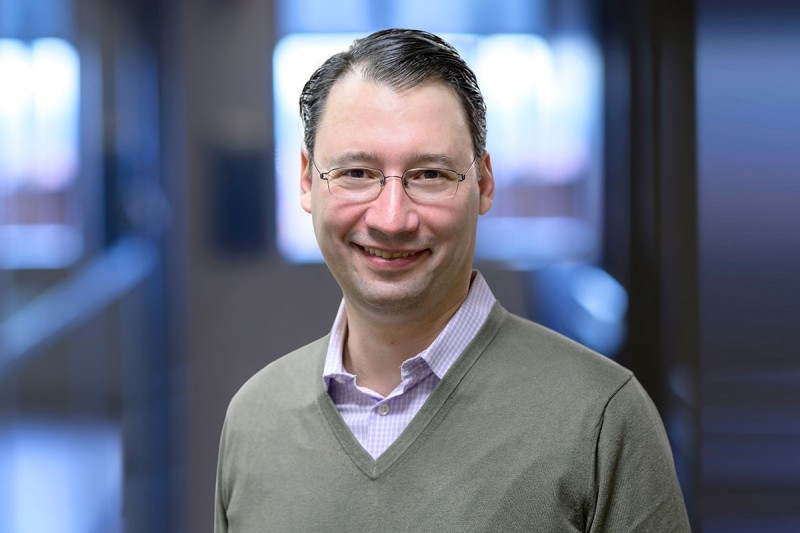
Epithelioid sarcoma, a rare aggressive cancer that usually strikes young adults, and rhabdoid tumors, which affect children, have long been difficult to treat. But the outlook for people with these subtypes of soft tissue sarcoma brightened in 2020 when the Food and Drug Administration approved a targeted therapy called tazemetostat (Tazverik™) for certain patients.
Memorial Sloan Kettering Cancer Center (MSK) sarcoma expert Mrinal Gounder, MD, led the research study that resulted in tazemetostat’s approval for people whose tumor contained a mutation (change) in a gene called SMARCB1. Unfortunately, tazemetostat has not worked in most people with the mutation, and some patients who initially respond develop resistance to the drug.
Now an MSK research team led by physician-scientist Alex Kentsis, MD, PhD, together with Dr. Gounder and colleagues, has identified mechanisms that activate resistance to tazemetostat in epithelioid sarcoma and rhabdoid tumors. Based on this discovery, the researchers designed a combination therapy that overcomes the resistance in a lab setting.
The combination therapy uses an epigenetic treatment strategy, which aims at altering the expression of genes. Epigenetic therapies are a new class of drugs that focus on modifying the activity of genes without changing the underlying DNA sequence. In some cases, these therapies can reprogram cancer cells to turn them into normal cells.
“By understanding the mechanisms of resistance, we were able to develop a combination therapy strategy that could improve treatment of not just epithelioid sarcoma but many types of cancer with similar epigenetic defects,” Dr. Kentsis says. The researchers report their findings in Cancer Discovery.
Mutation in SMARCB1 Leads to Overactive EZH2 Protein
Epithelioid and rhabdoid sarcomas develop when SMARCB1 is mutated. The gene is a tumor suppressor, which helps regulate cell growth and keep it in check. Loss of SMARCB1 function causes a protein called EZH2 to become overactive, driving the cell to grow uncontrollably and become cancerous.
In people whose tumors respond to tazemetostat, the drug blocks EZH2 and is able to restore the normal expression of genes, including those that regulate cell growth. This reprograms the cancer cells so they behave like normal cells. But in most patients, blocking EZH2 alone is not enough. Either the drug has no effect, or it works for a short time and then the cancer begins to grow again.
To understand how resistance to tazemetostat develops, Dr. Kentsis and colleagues studied samples donated for research by MSK patients with epithelioid sarcomas or rhabdoid tumors. They analyzed tumors from 33 patients using MSK-IMPACT®, a tumor-sequencing test that looks for mutations in more than 500 genes.
“It can be difficult to study rare cancers due to the challenge of getting enough tumors to generate answers,” Dr. Kentsis says. “But we were able to take advantage of being at a research institution like MSK, where our patients generously donate their samples and participate in clinical trials.”
Mutations Arise in Response to Treatment With Tazemetostat
In the tazemetostat-resistant tumors, the sequencing revealed a group of mutations that sometimes arise following treatment with the drug. The mutations were all part of a pathway that regulates how cells grow and divide, and has been linked to many cancers. The research team confirmed the link between the mutations and resistance to tazemetostat by studying cancer cells in a lab dish and tumors implanted into mice.
“By re-creating resistance in the lab, we were able to study the molecular mechanisms further and identify drugs that could be given in addition to tazemetostat,” Dr. Kentsis says. “This let us take a rational approach to developing a combination therapy, instead of doing it slowly by trial and error.”
The researchers tested a combination therapy using tazemetostat together with an experimental drug called barasertib, which targets mutations in the relevant pathway. This approach slowed tumor growth in mice, suggesting the treatment approach is promising.
Adding Immunotherapy to the Combination
Dr. Kentsis’ lab will also explore the possibility of combining tazemetostat with immune checkpoint inhibitors, which release a natural brake on the immune system so that immune cells called T cells recognize and attack tumors. Immunotherapy has been effective against some sarcomas, but the researchers need to understand how it would work in combination with epigenetic therapy. A successful combination with immunotherapy might provide a more lasting therapeutic response.
“Our long-term objective is to cure these patients definitively,” Dr. Kentsis says.
Grateful to Philanthropic Partners
Dr. Kentsis has long studied rhabdoid tumors and other childhood sarcomas. This type of ongoing research depends heavily on philanthropy, especially early-stage research that is typically not funded by government grants.
One major supporter of Dr. Kentsis’ research is Maggie’s Mission, a community of donors led by Donna and Steve Schmidt, who have raised money every year since 2017 in memory of their daughter.
“This research is especially notable because it was supported by Maggie’s Mission, a childhood cancer research philanthropy founded by the parents of one of our patients, whom we lost to rhabdoid tumor,” Dr. Kentsis says. “They are the reason this work cannot be done soon enough.”

